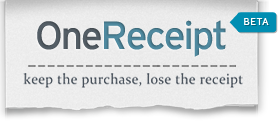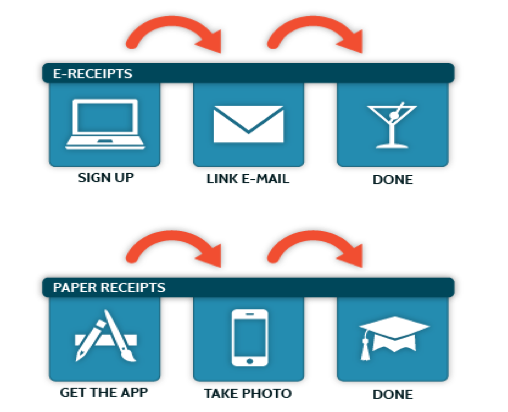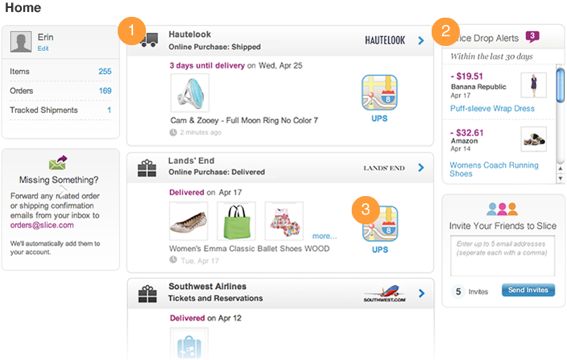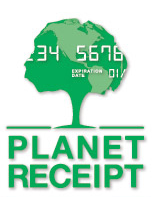Digital Receipt Management Tools (Part 1): OneReceipt, Shoeboxed and a Slice of Lemon
Last week, we reviewed the basics for dealing with receipt clutter flutter, including paring paper receipts down to just the essentials, then organizing and storing them. We also touched on how to manage simple digital receipts. Today, we’re going to expand on that digital focus to look at how we might maintain good financial records but have less reliance on the paper.
People want to avoid paper receipts for all sorts of reasons. Sorting receipts is tedious. They crumple and get messy. They come in odd sizes. Thermal paper receipts are laden with toxic BPA.
The following are some new tools for changing the way we interact with receipts.

Shoeboxed has been around since 2007. It’s best known as a service to which you can securely mail receipts to be scanned and collated into separate categories. Just gather your paper crumbles and insert them in Shoeboxed’s pre-paid envelopes. This not only gets receipts out of your home, but Shoeboxed magically turned the crumbles into sortable, analyzable data, which you can review without worry that your kids or kitties will destroy your deductibles documentation (or lick the BPA off of the paper).
Shoeboxed also has mobile apps to let you snap a photo and upload receipts when you’re on-the-go. Of course, you can also scan your own receipts and use the Receipt Uploader, or email receipts to your @Shoeboxed.com email address, although that seems somewhat less magical. Use that same email address as your default when registering with online merchants, and they can send receipts directly to your Shoeboxed mailbox. If your emailed vendor receipts come with discount codes or coupons for future purchases, Shoeboxed can manage those for you, too.
Shoeboxed uses high accuracy scanning, OCR, and human data verification to sort data and organize receipts into virtual shoeboxes, or categories, in your account. Result: no more hunting for receipts in shoeboxes of the cardboard variety. Shoeboxed also creates expense reports and can export receipt data to Quicken and TurboTax.
Shoeboxed has four pricing models, including a free DIY plan for those who have few receipts and are willing to scan for themselves.

OneReceipt, a digital service currently in beta, launched on Cyber Monday 2011. It combines your paper and electronic receipts, displaying them on a secure, personalized web page.
After a speedy sign-up, you get a personalized @OneReceipt.com address. Provide this address to vendors instead of your regular email address in order to protect your privacy and group your vendor notifications in one central area. (Personally, Paper Doll loves it when Amazon emails to tell me a package is on its way, but not everyone likes an inbox full of shipping data.) OneReceipt starts up by syncing with your Gmail, Google Apps or Yahoo! email to capture any electronic receipts that vendors have previously sent you.
Meanwhile, you can snap photos of your paper receipts and email them to your OneReceipt.com address for storage in the same account — use the iPhone app or just forward them from your inbox.

OneReceipt indexes all of your receipt information (for donations as well as purchases), and translates the data into a simple chart, with the date of purchase, order basics (company and order number), product, and financial information, including gross pricing, tax, discounts and net pricing. OneReceipt is allied with Expensify, so you can have detailed expense account information delivered directly to your inbox.
The service also offers tagging and categorizing to help you filter, sort, organize and retrieve whatever receipts you get. (When you’re emailing yourself, just type the tag in the email’s subject line.) However, there are only 15 categories, and it doesn’t appear you can add your own, and the tags are currently limited to Business and Personal.
OneReceipt generates a running total of your purchases, providing an effortless way to track your spending. Easily search through your purchases, narrowing by time frame or price.
OneReceipt also alerts you to deadlines for returning purchases so you don’t have to worry about posting a receipt (which you’ll surely ignore) on your fridge. The company takes a pretty lighthearted approach to itself in this regard.
If you use Google’s Chrome browser, you can also take advantage of an extension that lets OneReceipt play nicely with your Mint, American Express, CitiCards and Bank of America accounts, so that when you’re accessing those sites, you’ll be able to see more robust purchase data.
OneReceipt is free. Paper Doll expects it will eventually offer various levels of premium solutions.
[Edited to note: Effective August 24, 2016, OneReceipt is shutting down. An email from the company dated August 10, 2016 recommends migrating to its sister app, Slice.]

Slice, which turned one year-old in June, is less concerned with receipt clutter flutter than digital receipt disorganization, and focuses solely on organizing the receipts from your online purchases.
Sign up with one click using your Google, Yahoo! or Facebook accounts, or create an account with your name, email and password. From there, Slice asks you to select among Gmail, Yahoo!, Hotmail, AOL (seriously, Slice?) and iCloud — all web-based email accounts — to auto-import receipts; if you want to use other email providers, you have to create a Gmail account, link it to Slice and have it “fetch” from your regular email account. (Paper Doll is no programmer, but these extra steps seem a little clunky.)

For new purchases, track your shipments on a map, so you can see how far those cute shoes must travel to make it to you. Manually track personal packages, share tracking information with friends to whom you’ve sent gifts, receive real-time updates and view the contents of packages along with shipping data. You also have access to your shipment history, in case you need to have a (not-so) friendly discussion with a vendor.
Slice also tracks your purchase history, letting you sort by order date, merchant, status (purchased, rented, canceled or returned) or item type, including:
Online purchases
General payments
Digital downloads
In-store purchases at brick-and-mortar stores, like Nordstrom, that offer opt-ins for emailed receipts
Subscriptions or rentals
Tickets or reservations
Shipments, such as for repaired or exchanged items
The Slice & Dice function helps you analyze your purchase information, by merchant or price, over any set period of time.
Niftily, Slice detects and notifies you of price drops from merchants that honor price adjustments. Once Slice notifies you, you’re on your own to contact the store, but it’s a nice reminder. (Still, a service that could detect a price drop, automatically contact the company, get you a refund and have it deposited in your account? That would rock!)
Slice is a free service and is still in beta, though out of the invitation-only stage. As it grows, it will have more supported merchants, and, one hopes, more ways to get information into the system. Currently, mobile apps are available for iPhone and Android, in addition to the regular online Slice program. And, although I had to dig through the FAQ to find out, you can send digital receipts for unsupported vendors to your Slice account by emailing orders@slice.com from an email address already linked to Slice.

Lemon launched in October 2011, starting out as an iPhone-only app for helping store, sort and simplify paper and digital receipts. It now accommodates Android and WindowsPhone users, too. Lemon now sees itself as a “digital wallet that organizes and stores your credit cards, receipts, tickets, coupons and more.”
If you’re terrified of the BPA in receipts, or just know you’ll lose the paper ten seconds after it’s handed to you, snap photos at the cashier’s counter right when you check out. Otherwise, gather up a day’s (or week’s) worth of receipts and snap away! If applicable, you can also tag the receipt for the appropriate category, like business or personal.
For paper receipts, upload them using Lemon’s smartphone app. You merely point your smart phone at any receipt, being careful to line up the edges with the on-screen guide, and take a photo. For receipts that are too long to get in a single shot (and what’s the deal with foot-long receipts when you’re just buying milk and Reese’s Peanut Butter cups, anyway?), Lemon’s app program guides you through a series of shots. In that way, it’s kind of like taking a panoramic photo of the Grand Canyon with an old Brownie Instamatic. Lemon will assemble all the different shots to make it all make sense; no Xacto knives or rubber cement required.
Forward email receipts to your personal @lemon.com account; if they arrived to you as web pages rather than email, just use the instructions in last week’s post to turn them into files you can attach to any email.
If you don’t actually have a receipt (perhaps you paid a crisp dollar for an icy beverage at the neighbor’s lemonade stand?) you can still manually input information regarding your purchases so you can track every penny you spend.
Lemon will also let you log in to the Spending section and edit any receipt where data has been misinterpreted. Of course, as with any system, Lemon can only keep track of what’s put in, so it’s important to develop a reliable plan for uploading everything that isn’t already automated. Schedule a weekly upload time for regular statements and receipts and attend to ad hoc items you acquire. Buy a concert ticket? Scan it. Get your new insurance card in the mail? Up it goes!
Whatever method you use to send receipts and documents to Lemon, the service extracts any useful data so you can find whatever information you need to contact vendors about tracking, returns or warranties, and it can generate expense and any other financial reports, as necessary. All the receipts are filed and organized in one central, searchable account, and Lemon offers a graphic display of how and where you’re spending your hard-earned money.
Lemon comes in two flavors, ad-supported but free, and ad-free Lemon Pro at $9.99/month (or $99/year). Both versions allow the scanning of unlimited numbers of receipts, as well as credit, debit and loyalty cards. Both employ bank-secure PIN and SSL encryption, allow offline access to your financial information even when you can’t connect to the internet, and pass along special offers from your preferred merchants.
However, Lemon Pro is extra tangy, sporting “superfast processing” of scanned data. Features include scanning and storing receipts with line-by-line item detailing, tracking shared expenses for up to five people, and exporting of data to Excel, Evernote, Expensify and Concur.
Lemon’s major benefit is the high security; even if your smart phone is stolen, the information is kept behind a pretty impenetrable password. This means the thief can’t see your data, but once you replace your phone, you’ll be able to access your entire account.
Paper Doll found such an embarrassment of riches in terms of high tech ways to organize your receipts, we’re going to continue this topic next time with explorations of more digital receipt management tools.



![]()





Follow Me